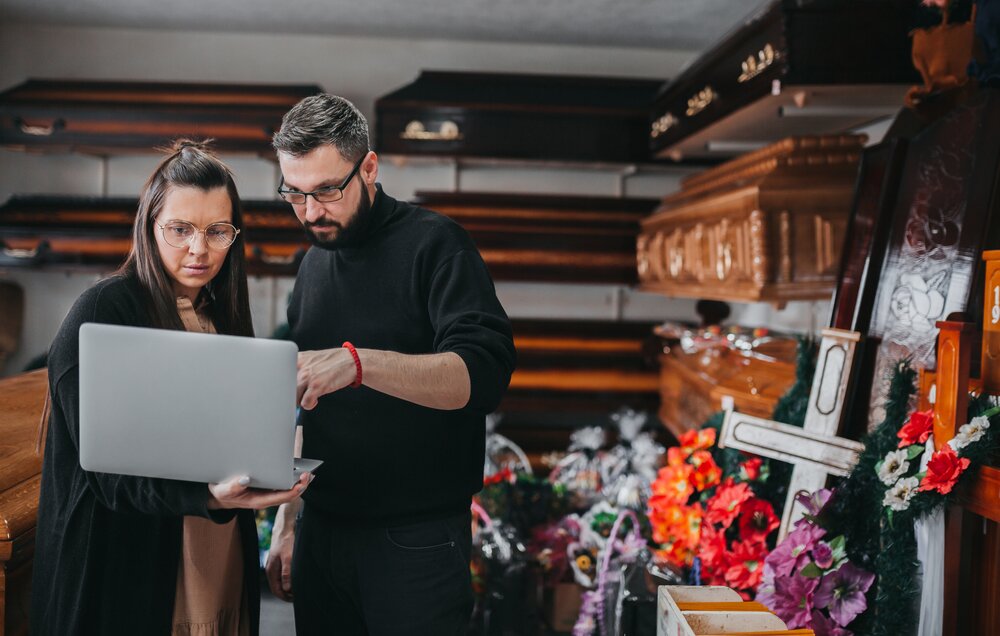(404) 312-6640
The Business Case for Funeral Streaming
For over 50 years, how funeral professionals helped families manage the details surrounding a loved one’s death changed very little. In early 2020, however, 80% of funeral homes quickly adopted various forms of live-streaming technology to help bereaved families cope during government-mandated restrictions on public gatherings.
]As a result, in just six months, live streaming became the first digital technology to achieve universal adoption across the funeral profession since websites began to appear 25 years earlier. The pandemic’s sudden, widespread upheaval placed tremendous pressure on funeral business owners and leaders to make best-guess decisions about which digital technologies would help them protect their businesses. Most struggled to evaluate the options and manage the tidal shift in customer needs and expectations. The majority responded by broadcasting ceremonies for free on Facebook Live. However, many suffered hard-learned lessons and deeply disappointing results, with broadcasts being muted, privacy issues, poor audio, and weak WiFi connections. While others turned to Zoom, they also struggled with guest interruptions, audio settings for music, and demands for technical support, while trying to maintain customary levels of in-person care for families and guests.
Evolution is the enemy
Despite these difficult experiences, funeral professionals overwhelmingly agree that funeral live streaming is here to stay—but behaviors and business practices aren’t lining up with the acknowledgment. Perhaps the digital scars of the past three years have persuaded many funeral professionals to passively resist clear social and business pressures for better digital services. We’ve observed that most funeral businesses don’t actively offer live streaming in arrangement conferences, relenting only when a family specifically requests it as a service. In connection with this, Chris Cruger, CEO of The Foresight Companies, has noted the “majority [still] think that it is going to go back to the way it used to be.”
The fact that the profession’s overall capacity to livestream and offer digital services has not evolved much since 2020 seems to bear this out. This current state of the profession stands in stark contrast to the accelerated and sustained advances in consumer expectations and available streaming technologies. Based on company research, Cruger recently predicted that “there will be 3,000 to 4,000 fewer funeral homes in the next four to eight years,” contending that only innovative firms that adapt well to change will be the ones that survive and thrive. If he’s right, the profession won’t have another 25 to 50 years to make needed changes.
Opening the digital door
In this context, the business plan of a thriving funeral business must certainly acknowledge the need for both digital and digitally enhanced services. Today’s funeral consumers, regardless of their memorialization preferences, expect to be able to be more aware of and engaged in the arrangement process if they choose to be. They want transparency in processes, products, and pricing. They want easy access to information and tools to help them make their decisions. And they want the flexibility to make those decisions with others (or with the advice and reviews of others), in the time and place they choose. It doesn’t mean they don’t want to meet with you in person. It simply means they perceive significant value in being able to work with you in open, convenient, and collaborative ways. They know that’s what digital services can do for them. While there are literally hundreds of digital tools available to streamline your processes and enhance your customer experience, what you decide to do ought to be a deliberate decision based on your business plan, addressing an area you know needs improvement. Whether that’s an internal process you need to automate or a digital service that needs refinement, start with what you know.
Live Streaming as a way forward
Perhaps the biggest challenge facing business leaders who want to respond to changing consumer preferences is the ability to invest in that change. Forecasting your return on investment (ROI) with little digital business experience or expertise can be difficult. That’s why starting with what you know makes sense and can be an important first step toward a broader digital transformation. While the decision to begin live streaming may have been made of necessity, you now know there’s demand for it. Begin charging for live streaming as a service, if you don’t already do that. Or, if you’re concerned about the quality or brand experience you’re charging for, consider upgrading your streaming platform from Facebook or another older funeral platform. These small upgrades can quickly pay for themselves. Here’s how.
Unlocking the Hidden Business Value
Digital services, like your website, work for you in ways you can’t. An effective livestream platform offers ways for online guests to interact with your brand and your company. While you are taking care of in-person needs, it’s busy building trust and confidence in your business and the value of the services you provide. You’re connecting with an expanded and uniquely targeted audience without doing anything more than you do today to livestream a ceremony. What’s different about live stream audiences is that they have experienced a loss, they have a direct connection to your community (no matter where they watch from), you have provided a valuable service to them, AND they provided you with their contact information and permission to contact them. That is what can boost the value of each live stream for your business from just $200 to $10,000. An average of 40 guests register to attend a funeral ceremony via live stream (not even including those who will attend with them). If you livestream 30 ceremonies this year, you’ll have served 1,200 additional guests directly. If 5% of those guests purchase $5,000 in services from your business over the next 5 years, you’ll add 60 new customers and $300,000 in revenue. By simply streaming more often, you can boost your lead generation program and your new business pipelines. Using your own numbers, consider the long-term benefits of adding regular live streaming to your service offerings. By ensuring you offer livestream guest experiences that are professional, engaging, and fully brand-aligned, you’ll be connecting your business directly with a bigger market. The results will not only justify a modest investment in live streaming but can also create added flexibility to invest further in digital business tools.
The difference is the data
It is important to note that these kinds of results are dependent on collecting and using the information that guests provide you with when they register to attend a ceremony via live stream. Their contact information, also known as First-Party Data (i.e., the information you collect through your business processes), is key to your being able to reach potential new customers in thoughtful ways and at a time when they are reflecting on what families go through when a loved one dies. It’s the right time after you have provided them with a meaningful online experience, to offer information on grief support or about your pre-need planning services. At the same time, you’ll be keeping your funeral business top-of-mind for them, selling more funerals, and growing your market share.
Engage with expanded audiences
There will always be reasons why family members and friends cannot attend a funeral ceremony or memorial service in person. While simply streaming meets an important need for them, these guests often lament their inability to do more to personally demonstrate their deep care and sympathy to the family. Providing opportunities for meaningful online engagement is vital to meeting these deeper needs and building trust and value in your relationship with them.
Consider upgrading your platform or approach to enable online guests to share condolences and memories through messages, photos, and personal recordings while attending the live stream. These personal gifts are meaningful and valuable to your families as well. There are platforms that, similarly, also allow bereaved families to manage privacy and personalize the memorial page with videos and pictures for their guests to enjoy alongside the live stream or recording. Your business can benefit from creating simple, beautifully refined, and fully-branded spaces and experiences that welcome guests and enable you to build and strengthen the relationships of trust that your business depends on to grow and thrive in a digital world.
Making the case
While the profession hasn’t generally kept pace with digital technology advancements, live streaming is an important step forward that nearly every funeral business has taken. Considering the facts, a compelling business case can be made for making live streaming a central part of your business development strategy and direct marketing efforts. Leveraging your own practical experience and the technology you probably already have, this opportunity for business growth is still well within reach. In fact, the potential value in your live streaming could represent your business’ smoothest path forward to growth and delivering even more services digitally in the future.






Comments